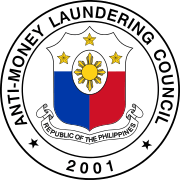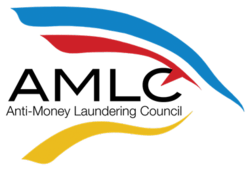Anti-Money Laundering Council (Philippines)
|
AMLC Seal | |
| Agency overview | |
|---|---|
| Formed | 2001 |
| Jurisdiction | Philippines |
| Headquarters | AMLC Secretariat, BSP Complex, Manila , Philippines |
| Agency executive |
|
| Website |
www |
The Anti-Money Laundering Council (AMLC) Philippines government agency tasked to implement the provisions of Republic Act No. 9160, also known as the “Anti-Money Laundering Act of 2001” (AMLA), as amended, and Republic Act No. 10168, also known as the “Terrorism Financing Suppression Act of 2012” (TFPSA). It also acts as the financial intelligence unit (FIU) of the Philippines.
The AMLC may refer to (1) the government agency or (2) the Council, which heads the said government agency.
Mandate
The AMLC is mandated to protect and preserve the integrity and confidentiality of bank accounts and to ensure that the Philippines shall not be used as a money laundering site for the proceeds of any unlawful activity. It also extends cooperation in transnational investigations and prosecutions of persons involved in money laundering activities wherever committed.
The Council
The AMLC is composed of the Governor of the Bangko Sentral ng Pilipinas (BSP) as Chairman and the Commissioner of the Insurance Commission (IC) and the Chairman of the Securities and Exchange Commission (SEC) as members. It acts unanimously in the discharge of its functions.
The AMLC Secretariat
The AMLC is assisted by a Secretariat headed by an Executive Director and consists of four (4) units:
- Office of the Executive Director (OED)
- Compliance and Investigation Group (CIG)
- Legal Services Group (LSG)
- Information Management and Analysis Group (IMAG)
Under the OED are the Technical Services Staff (TSS) and the Administrative and Financial Services Division (AFSD).
Under the IMAG are the Financial Intelligence Analysis Staff (FIAS), Data Collection and Management Staff (DCMS), Application Development Staff (ADS), and the IT Support Staff (ITSS).
Roles of AMLC

(1) to require and receive covered or suspicious transaction reports from covered institutions;
(2) to issue orders addressed to the appropriate Supervising Authority or the covered institution to determine the true identity of the owner of any monetary instrument or property subject of a covered transaction or suspicious transaction report or request for assistance from a foreign State, or believed by the Council, on the basis of substantial evidence, to be, in whole or in part, wherever located, representing, involving, or related to, directly or indirectly, in any manner or by any means, the proceeds of an unlawful activity.
(3) to institute civil forfeiture proceedings and all other remedial proceedings through the Office of the Solicitor General;
(4) to cause the filing of complaints with the Department of Justice or the Ombudsman for the prosecution of money laundering offenses;
(5) to investigate suspicious transactions and covered transactions deemed suspicious after an investigation by AMLC, money laundering activities, and other violations of the Act;
(6) to apply before the Court of Appeals, ex parte, for the freezing of any monetary instrument or property alleged to be laundered, proceeds from, or instrumentalities used in or intended for use in any unlawful activity as defined in Section 3(i) hereof;
(7) to implement such measures as may be necessary and justified under the Act to counteract money laundering;
(8) to receive and take action in respect of, any request from foreign states for assistance in their own anti-money laundering operations provided in the Act;
(9) to develop educational programs on the pernicious effects of money laundering, the methods and techniques used in money laundering, the viable means of preventing money laundering and the effective ways of prosecuting and punishing offenders;
(10) to enlist the assistance of any branch, department, bureau, office, agency or instrumentality of the government, including government-owned and -controlled corporations, in undertaking any and all anti-money laundering operations, which may include the use of its personnel, facilities and resources for the more resolute prevention, detection and investigation of money laundering offenses and prosecution of offenders;
(11) to impose administrative sanctions for the violation of laws, rules, regulations and orders and resolutions issued pursuant thereto; and
(12) to require the Land Registration Authority and all its Registry of Deeds to submit to the AMLC, reports on all real estate transactions involving an amount in excess of Five hundred thousand pesos (P500,000.00) within fifteen (15) days from the date of registration of the transaction, in a form to be prescribed by the AMLC. The AMLC may also require the Land Registration Authority and all its Registry of Deeds to submit copies of relevant documents of all real estate transactions.”
Predicate Crimes/Unlawful Activities
- Kidnapping for ransom
- Drug trafficking and related offenses
- Graft and corrupt practices
- Plunder
- Robbery and Extortion
- Jueteng and Masiao
- Piracy
- Qualified theft
- Swindling
- Smuggling
- Violations under the Electronic Commerce Act of 2000
- Hijacking; destructive arson; and murder, including those perpetrated by terrorists against non-combatant persons and similar targets
- Fraudulent practices and other violations under the Securities Regulation Code of 2000
- Felonies or offenses of a similar nature that are punishable under the penal laws of other countries.
- Terrorism financing and organizing or directing others to commit terrorism financing (R.A. 10168).
- Attempt/conspiracy to commit terrorism financing and organizing or directing others to commit terrorism financing (R.A. 10168).
- Attempt/conspiracy to commit dealing with property or funds of designated person.
- Accomplice to terrorism financing or conspiracy to commit terrorism financing.
- Accessory to terrorism financing.
Covered Persons
- Banks and all other entities, including their subsidiaries and affiliates, supervised and regulated by the Bangko Sentral ng Pilipinas
- Insurance companies, pre-need companies and all other institutions supervised or regulated by the Insurance Commission
- Securities dealers and other entities supervised or regulated by the Securities and Exchange Commission
- Jewelry dealers
- Dealers in precious metals
- Dealers in precious stones
- Company Service Providers (CSP)
- Non-designated persons, including lawyers and accountants
Covered & Suspicious Transactions
- "Covered Transaction" refers to:
1. A transaction in cash or other equivalent monetary instrument exceeding Five Hundred Thousand pesos (Php500,000.00) 2. A transaction exceeding One Million pesos (Php1,000,000.00) in cases of jewelry dealers, dealers in precious metals and dealers in precious stones.
- "Suspicious Transaction" refers to a transaction, regardless of amount, where any of the following circumstances exists:
1. there is no underlying legal or trade obligation, purpose or economic justification;
2. the client is not properly identified;
3. the amount involved is not commensurate with the business or financial capacity of the client;
4. taking into account all known circumstances, it may be perceived that the client’s transaction is structured in order to avoid being the subject of reporting requirements under the AMLA;
5. any circumstance relating to the transaction which is observed to deviate from the profile of the client and/or the client’s past transactions with the covered person;
6. the transaction is in any way related to an unlawful activity or any money laundering activity or offense that is about to be committed, is being or has been committed; or
7. any transaction that is similar, analogous or identical to any of the foregoing.
Laws Covering the AMLC
- Republic Act No. 9160 - Anti-Money Laundering Act (AMLA) of 2001
- Republic Act No. 9194 - Amending the AMLA
- Republic Act No. 10167 - Strengthening the AMLA
- Republic Act No. 10365 - Further Strengthening the AMLA
